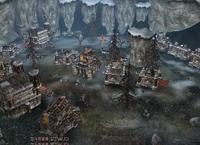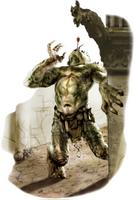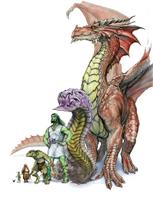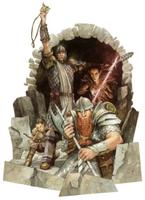|
|
|
Main News Forums Games Games Database Top 100 Release List Support Files Features Reviews Previews Interviews Editorials Diaries Misc Download Gallery Music Screenshots Videos Miscellaneous Staff Members Privacy Statement |
Random Dialogue: A Reverie on Pen and Paper Gaming
The design of most massive games, of course, owes a great deal to D&D. The early MUDs and MUSHs cribbed a great deal from the TSR game, and as a result the graphical games built on their backs have the same flavour. Without "The Temple of Elemental Evil", we may never have fought Nagafen or Lady Vox. Even beyond massive games, Dungeons and Dragons and it's brethren lent creative energy to games development. The adventures of the iD Software krewe in their early dungeoneering days led to the likes of Quake and formed elements even today of Doom 3. The spark of creativity and the interest in the fantastical that many designers share almost certainly harkens back to their time spent underground hunting for lost treasure, or saving hapless villagers. Before you lies a great plain filled with tended fields of wheat. Diligent villagers work the tight rows of grain as you look on. The sky is a sharp blue, with only a few whispy clouds occasionally obscuring the sun. The smell of autumn and the harvest is on the air as you enjoy the view. Suddenly, a shadow passes in front of the sun, darkening the field. You look up and, backlit against the sky, see the serpentine form of a red dragon glide into view. The great beast rears back it's head, and flames billow forth from it's gaping maw to engulf a field of foodstuffs. Grimacing, you tighten your grip on your sword... This scene, or something very much like it, was my first exposure to Dungeons and Dragons. I'd been playing the poorly named "Teenage Mutant Ninja Turtles and Other Strangeness" game for about a year, and I was getting tired of portraying the role of a ninja weasel. I was 11, and another kid at my grade school brought the basic rules one day at recess. This wasn't even 2nd Edition, mind you, this was straight AD&D. Me and two other dorks rolled up characters on the asphalt, in the corner of the parking lot behind the basketball hoops, and our long-on-talk short-on-game DM gave it a go. The three of us (fighter, cleric, and wizard) were to save this town from the depredations of the red wyrm circling above us. Unfortunately for our earstwhile team, our budding DM didn't really understand the concept of scaling an encounter to fit the level of his players. The dragon we were facing was an adult. In Dungeons and Dragons, the older a wyrm gets, the more powerful it is. In AD&D, an adult dragon could have basically killed a 1st level wizard by squinting at him. (These are the same wizards who, sadly, could be killed by common housecats 65% of the time.)
Granted, I've done very little princess rescuing or village saving now that I'm ostensibly an "adult". Just the same, those are not the kind of situations the average 11 year old has to deal with. "How do I get the villagers to safety without endangering them?" Even within the limited confines of our youthful minds, those were weighty questions with some serious implications. Problem solving seems to be one of the big factors involved in the mysterious process of growing up, and solving problems is pretty much all you do in pen and paper gaming. If not for the inneffectuality of the average village-dweller, I don't think there would be many adventurer's with livelyhoods. This hands-on, trial and error approach to weighty issues has undoubtedly played an important role in the maturity of many a die rolling neophyte.
While Massively Multiplayer games are without a doubt beautiful works, there will always be a place for pen and paper gaming. There is nothing like a group of friends sitting down to an evening of dragon slaying, kindgom saving, and storytelling. Pen and paper gaming is an emminently social activity that will likely always play a role in encouraging people down a path towards geekhood. I'll have a lot to talk about when I get back from the Con of Cons. Until then...
|
||||||
|
All original content of this site is copyrighted by RPGWatch. Copying or reproducing of any part of this site is strictly prohibited. Taking anything from this site without authorisation will be considered stealing and we'll be forced to visit you and jump on your legs until you give it back. |
||







